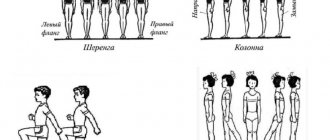Human muscles are designed to move his skeleton in space.
And move objects relative to the skeleton. This is the same for all people. The only question is how we can do this: how much, quickly and powerfully, with what amplitude and for how long. And any training is aimed at developing the listed qualities. Read more about this in this article, and here we will move on to the more practical part - choosing the right exercises for optimal development of our body. But first, I will still briefly go over the main theses on which we will rely.
Our body was originally created by nature and evolution not to be anything outwardly. On the contrary. It takes shape depending on our lifestyle. That is, as much as we CAN, we look like that. This is the most natural way to be beautiful - to first become healthy. Because beauty is just an indicator of health (there is a separate article on this topic).
To become healthy and develop effectively in a functional direction (and, as we found out, this will also change us externally for the better), we need to move in a certain way. In other words, use yourself as intended. And in practical terms, this means training the basic movements for which our body was originally created.
And there are essentially only three types of such movements. These are pushing movements : when we push something away from ourselves or move it away from ourselves (press). Pulling movements are when we pull something towards ourselves or ourselves towards something. And, roughly speaking, kicking . That is, when we push something away with our feet. Or yourself from the earth.
It turns out that the body's systems are designed to push, pull and kick. And, no matter how you look at it, all physical labor, fighting (hunting), gathering - everything is based on these movements. That is why they are called basic. Let's look at them in a little more detail.
"Dancing with Tambourines" | "Tambourines dances"
“Dancing with tambourines” is an expression that means long, difficult and often unjustified from the point of view of common sense attempts to achieve one’s goal. Salespeople of all stripes and industries hate “dancing with tambourines” because it wastes their time, energy and resources on lengthy bureaucratic and formal procedures and delays that are so often guilty of large companies. A client who says that he likes the solution (product, service), but “now he needs to show it to the head of the transport department”, then “he needs to prepare a separate proposal for the commercial director”, then “he needs to justify the financial sense of this purchase”, then “I should show the product to the director,” etc. The seller’s ability to avoid all these “dances with tambourines”, going straight to demonstrating the product or service to the decision maker, is valued by managers as the skill of a true professional. If the company’s business involves numerous and constant “dances with tambourines,” it is necessary to divide the sales department into divisions of “hunters and peasants.” Hunters must look for new clients and make bright presentations, peasants must “dig and hammer” already found clients, carrying out all the formal and “petty dance” elements, getting all the papers signed.
Exercises
Rowing with a sports sled
Stand facing the sled and grab the two straps in front of you with your hands. Pull them and quickly pull the sled towards you. Take a couple steps back and repeat. Perform, calculating the distance or number of repetitions. This exercise can also be performed with one hand and for a while, or with both hands, using one cable instead of two belts.
https://youtu.be/cwleDtPiYbo
Traction
This is a favorite exercise for National Football League players who want to develop explosive power to launch off the line. Take the straps and stand with your back to the sled, keeping your hands and the strap between your legs at knee level. Tighten your knees and lower your body to your hips, then suddenly straighten forward. Repeat for distance or number of repetitions.
https://youtu.be/fVeoEJnvAOc
Bear walk
For the exercise you will have to tie the straps to your belt or vest. Get down on all fours and try to keep your back straight. Move forward by distance or time.
https://youtu.be/-9jarYymKT8
Sprint with sleds
Using a weighted sled (or a racing sled if you're lucky enough to get your hands on one). Place your hands on the handles and push the structure forward as fast as possible. Try to stay on half-bent legs to improve the transfer of force and not stop.
https://youtu.be/PcDBaQmpq78
Trade margin | Trade margin
Trade margin is the difference between the full purchase price of a product (including costs of transportation, packaging, logistics, bribes, etc.) and the cost of selling the product to end customers. The markup is what any business works for. The markup should cover all production and any other expenses of the enterprise, including salaries, taxes, rent and advertising, and include money for growth and possible unforeseen expenses. All the advertising that we see, all the stores, all the counters, price tags, shop windows, cash registers, directors’ Mercedes, television commercials and “free” plastic bags are paid for by us, the customers. We pay not only for the goods, but also for the entire business of the enterprise. The difference in trade margins can affect consumer activity. There are grandmothers who, because of a difference of 50 kopecks, will go to the other end of the city. There are boutiques that, having learned that the same boutique has opened next to them, double their prices in order to differentiate themselves from competitors and retain a more “expensive” audience. Sellers must understand the client's company's policy regarding trade margins and vary their arguments depending on this. Also, sellers must know well their markup on the product in order to “play” with discounts within reasonable limits and always remain profitable.
Coach | Trainer
A professional who specializes in transferring knowledge, skills and abilities to students in a business training format. During the training process, the trainer transfers knowledge and develops the skills necessary for the future effective work of employees. The range of skills required by employees is formed depending on the company’s objectives, its scale, industry specialization and the current level of students. In most companies, the tasks of a business coach include a full cycle of work related to the development of training, collecting and filling it with the necessary information, developing a training format, preparing handouts, cases, games, etc. Sellers encounter trainers during trainings and often professional sellers know how, where, to whom and what to sell much better than the trainer, so the trainer must also have good psychological and practical preparation.
Consumer goods (FMCG) | Commodities (Commoditised products and services)
Consumer goods and services are goods and services that are frequently purchased and consumed by the public and that are produced, provided and sold on a huge scale, with little to no variation between goods and services from different suppliers. Consumer goods are characterized by large volumes, low price, low profit margin per unit, no need to involve specialists for sales, ease of use, consumption, application and installation, etc. Traditionally, consumer goods refers to mass consumption markets in which the state regulates prices in retail trade for goods such as bread, flour, butter, sugar, salt, matches, coffee, vodka, etc. Or such mass services as passenger transportation, hairdressing services, home maintenance, etc. However, in the field of professional sales, consumer goods have recently come to be called any understandable products and services that have become widely available and widely used. These are computers, mobile phones, TVs, mp3 players, plastic bags, yoghurts, candies, plywood, etc. Consumer goods belong to the mass market, so they are subject to large-scale trade distribution methods, in contrast to specialized or complex goods, which, as a rule, require direct sales or advertising, certain expertise and additional costs in narrow market segments. With some generalization, consumer goods can include any product or service that is sold to a million buyers or more. Over time, all consumer goods and services either become consumer goods or disappear, replaced by other goods and services. 5 years ago I bought a 50″ Panasonic plasma TV for $6,000 (180,000 rubles at the current exchange rate). 10 years ago, a color TV of the same size cost $20,000. Today such TVs cost 30,000 rubles and continue to get cheaper. Even cars are becoming consumer goods, and within the next 30 years, country houses are likely to become so.
Trade negotiations | Trade negotiations
Sales negotiations are one of the key processes in business sales, which lasts from the letter or call stage to the signing of the contract. The key goal of trade negotiations is to find and find a solution that satisfies both parties - the buyer and the seller. Typically, in retail sales there is no negotiation stage, but in business sales it is key. Most often, within the framework of trade negotiations, the skills and abilities of the seller and his ability to influence the results of the interaction process are revealed. During well-constructed negotiations, points of contact and possible mutual interest are first identified, possible tasks and problems facing the buyer are described, the seller is offered possible solutions, the benefits and advantages of individual solutions, the conditions under which they can be sold and purchased, as well as other issues that affect the transaction. Part of trade negotiations includes such aspects as bargaining, concessions, reference, presentation, exchange of opinions and others.










